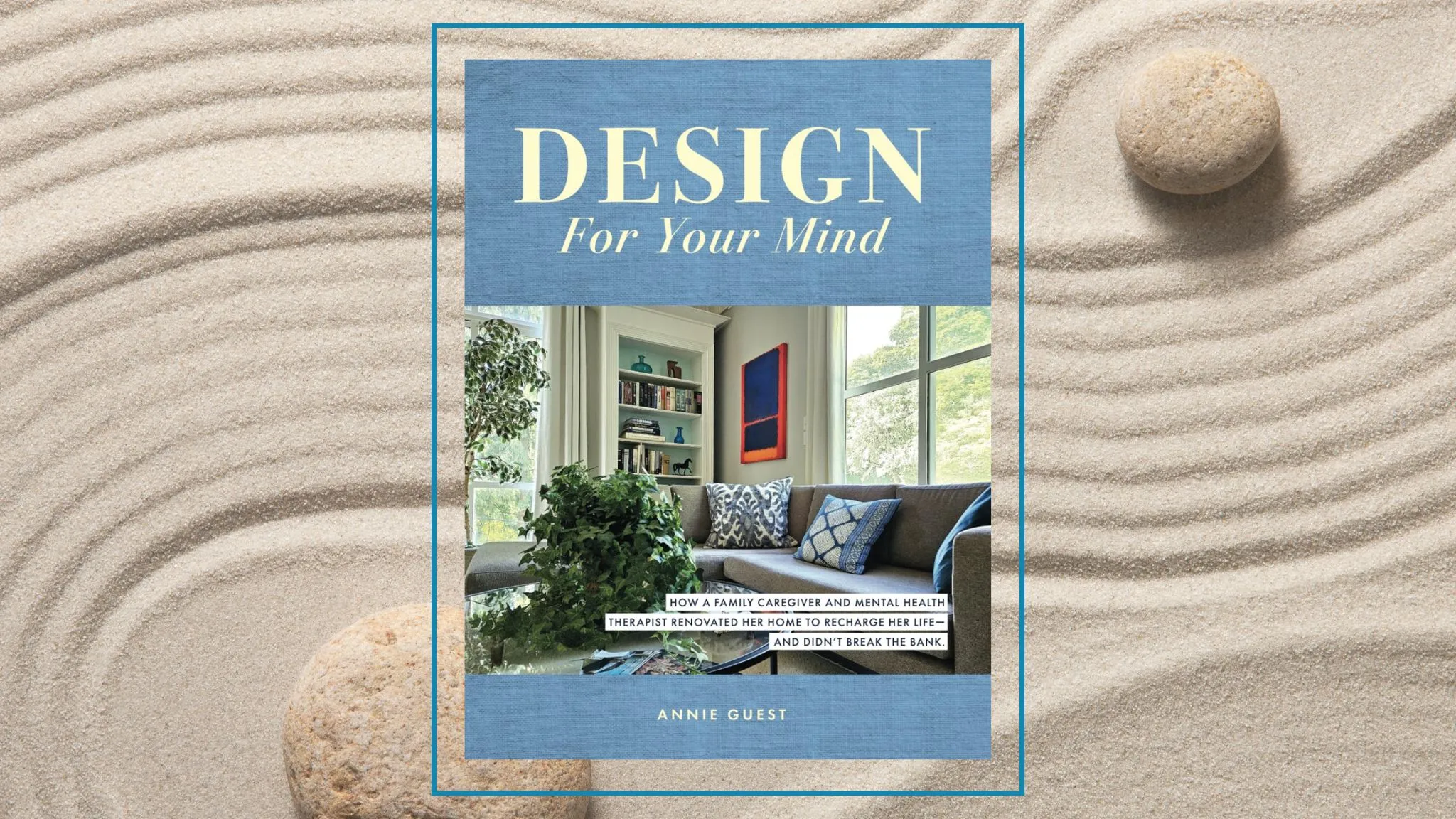Design for Your Mind by Annie Guest
Annie Guest has crafted a unique guidebook that proves interior design isn’t just about making things look pretty — it’s about making a life that feels whole.
Can redecorating your home truly change your life? In the case of Annie Guest, a family caregiver turned interior designer, the answer is a resounding yes. Her debut book, Design for Your Mind: How a Family Caregiver and Mental Health Therapist Renovated Her Home to Recharge Her Life—and Didn’t Break the Bank, is far more than a home makeover story.
It’s an uplifting blend of memoir and design guide that shows how transforming living spaces can go hand in hand with transforming one’s mental and emotional well-being. In a warm, conversational tone, Guest invites readers into her very personal journey of loss, healing and creative renewal, all while delivering practical tips and inspiration for anyone looking to refresh their home on a budget.
At the Intersection of Interior Design and Mental Health
From the very first pages, Guest’s unique perspective as both a mental health therapist and a devoted daughter shines through. After years of caring for her aging parents through illness, Guest found herself drained and grief-stricken when they passed. Inheriting her parents’ century-old, Greek-Revival family home, she decided to rebuild not just the house, but also her own sense of purpose. As she writes, this project was her way to “recharge her life” after caregiving, using interior design as a form of therapy.
The result is an approach she eventually named “Benessent Design,” from the Latin bene essere, meaning “well-being.” This concept centers on designing spaces that support mental wellness and cognitive function just as much as aesthetics. Guest treats our mind’s needs as equal to our physical needs — a philosophy that feels both timely and refreshing in an era when many of us need a sanctuary from the anxieties of the workaday world.
Throughout the book, she cites evidence and psychology research to back up her ideas, but always in a reader-friendly way. For example, she discusses how a low-clutter, well-organized environment can reduce stress and improve focus (and other executive functioning skills) and how elements like natural light, plants and comforting textures can soothe anxiety and lift mood. It’s clear that her therapy background informs every design choice, whether she’s talking about creating a calming nook for reflection or setting up a home office that minimizes distraction.
A Personal Journey from Caregiving to Creativity
What makes Design for Your Mind especially engaging is the personal narrative woven throughout. Guest isn’t an aloof designer dispensing generic advice; she’s a woman rebuilding her life, and she lets us accompany her every step of the way. She movingly recounts her time as a caregiver for her father (who battled Parkinson’s) and her mother (who was wheelchair-bound and later affected by dementia). The toll of late-night emergencies, hospital visits and emotional exhaustion is palpable. Guest describes how she “began to lose herself” under the weight of responsibility, a sentiment that will resonate with anyone who has cared for a loved one.
After her parents’ passing, she faces the bittersweet task of sorting through their lifetime of belongings and memories in the old family home. Rather than sell the house, she decides to honor her parents by reimagining it — keeping the happy memories alive while shedding the sadness of their final years. This very personal motivation drives the book’s heart. As readers, we feel her grief, but also her determination to find hope and “make room for [her] brilliant life” again.
Guest’s tone is honest and heartfelt; she doesn’t shy away from the difficulties of caregiving or the grief that follows. Yet, the narrative is never dour. In fact, it’s inspiring to see how she channels these heavy emotions into creativity. Renovating the house becomes a cathartic project, giving her a focus and a way to heal. By sharing anecdotes like picnicking on Subway sandwiches with her parents in the car or camping out on their bed for late-night chats, Guest infuses the design journey with touching family memories. These stories make the book as much about love, loss and resilience as it is about furniture and paint.
Room-by-Room Inspiration and Transformation
The structure of the book follows the actual renovation process, taking readers room by room through Guest’s home and even the surrounding property. Each chapter focuses on a specific space, effectively becoming a mini makeover story complete with “before” and “after” descriptions and photos.
Throughout these chapters, Guest shares plenty of practical insights — like how she auditioned paint colors using free online tools, created Pinterest boards for each room to gather ideas, and sourced affordable finds from Etsy, eBay, thrift shops and discount retailers.
She proves that high style doesn’t require a high budget: one chapter even includes a section on “supporting small businesses,” where she highlights decor pieces she bought from artisans and vintage sellers. This DIY-friendly, resourceful spirit runs through the book and will encourage readers to get creative with their own sourcing.
Practical Advice, Psychology and Plenty of Style
For a book that delves into neuroscience and mental wellness, Design for Your Mind is never dry or pedantic. Guest has a gift for explaining concepts like executive functioning or the benefits of an “enriched environment” in plain language, often with a touch of humor. The advice is actionable: she suggests creating specific zones in your home for specific activities (work, play, exercise, relaxation) to give your brain structure, and unpacks the emotional side of decluttering.
Visually, the book is a treat. It’s filled with dozens of color photographs, including dramatic before-and-after shots that document each space’s evolution. Readers who love HGTV-style reveals will find these images hugely satisfying.
Yet, even with all the how-to content, the prose remains engaging and narrative-driven. Guest’s writing style is clear and friendly, with an enthusiasm that bubbles up as she discovers each solution. You can sense her excitement when a plan comes together, and she manages to educate and motivate readers without ever feeling like a lecture. In fact, reading it feels like chatting with a supportive friend who happens to have great design sense and a background in psychology.
A Guide for Readers Seeking Comfort and Creativity
Guest’s Design for Your Mind succeeds on multiple levels: it’s a heartfelt memoir of starting over, a practical interior design handbook, and a gentle lesson in self-care and personal growth.
If you’re a caregiver or someone who has gone through a major life transition, you may find solace and inspiration. If you’re a home décor enthusiast, you’ll relish the room-by-room breakdowns, the styling tips and the before-and-after eye candy. And if you’re curious about how environment affects your mental health, Guest provides plenty of food for thought.
Importantly, the book stays positive and empowering throughout. Guest avoids negativity; in design, she emphasizes working with what you have and improving it, rather than criticizing the “ugly” parts of the old house. Similarly, in life, her tone suggests that it’s never too late to reinvent your space or yourself.
Design for Your Mind is an absorbing and uplifting read that will appeal to a wide audience. Annie Guest has crafted a unique guidebook that proves interior design isn’t just about making things look pretty — it’s about making a life that feels whole. And she graciously shows us how to do it, one room at a time.
Annie Guest had a varied career in book publishing, advertising, and law, before she took another jump to work as a mental health therapist and publish her first book. As a therapist, Annie treats children, teens, and adults in traditional sit-down sessions. But more often, she brings horses and ponies together with clients for a therapy called equine-assisted counseling. As a writer, Annie combines her passion for people and their potential with her love for interior design and her appreciation for the life choices that support mental health.

Publish Date: 2/1/2025
Genre: Nonfiction
Author: Annie Guest
Page Count: 190 pages
Publisher: B. D. Walsh Publishing LLC
ISBN: 9798992203325

